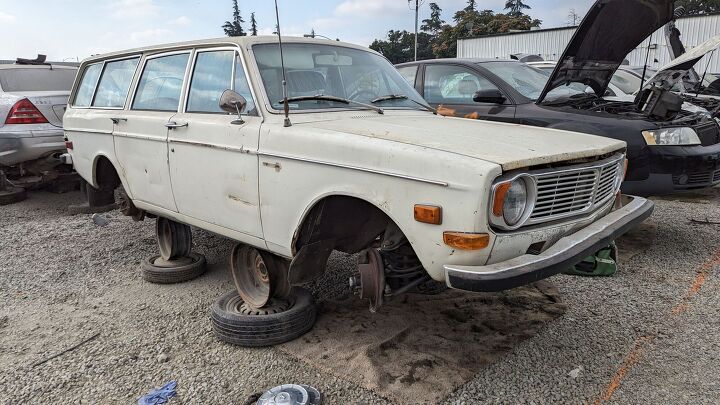Because Volvo sold the 200 Series cars here from the 1975 through 1993 model years and so many owners loved those sensible bricks so deeply, plenty are only now showing up in the self-service car graveyards I frequent. What about the 200’s predecessor, the 140?

While not as easy to find as the 240 in Ewe Pullet yards these days, I still run across one or two 140s in junkyards per year, mostly in Volvo brick-loving Northern California. This one now resides in the same San Jose Pick-n-Pull as three Renault Dauphines (including a Gordini).

If you go there, make sure you get some tacos from the roach coach out front; it’s one of the best junkyard taco trucks in the Golden State (which is saying something).

Like so many old Volvos I’ve found in junkyards in recent years (including a 240 with better than 600,000 miles on the odometer), this one has the look of a car that spent most or all of its life with one owner who loved it very much.

It’s very well-preserved, with seats swapped in from what I assume was an early 240 and other signs of meticulous care for a reliable, if elderly daily driver. For example, this envelope with some carb gaskets I found in the glovebox.

On the back is a lengthy description of the details associated with a very careful rebuild of the Skinners Union carburetors.

Having daily-driven a few cars equipped with dual SUs, I know and love/hate this hardware quite well (and I can say that the license-built Hitachi versions used on Datsuns have far superior build quality).

Volvo was an early adopter of the six-digit odometer, so we can see that this car traveled close to 250,000 miles during its life. Did the owner finally trade it in on a new Volvo?

Plenty of curmudgeonly Silicon Valley tech-industry workers drove old Swedish cars to work for decade after decade.

The 140 and 240 Volvos were essentially the same car from the A pillar back, as is made clear from the side view. The 200 Series ( which included the 260 six-cylinder cars) got a modern MacPherson strut front suspension but otherwise didn’t change much.

All the 140s got B18 and B20 pushrod straight-four engines, continuing the tradition of tractor-grade B-series Volvo power that went all the way back to the PV444s of the middle 1940s (and through the US-market PV544 and Amazon).

The 240 got the B20 here as well, though only for the 1975 model year. After that, the 240 went all overhead-cam. There were six-cylinder members of the 140 family, but only in sedan form.

140s with automatics were available, of course, but this car has the four-on-the-floor manual you’ll find in most of these cars.

The old-school aftermarket AM radio shows “BC” (which meant “Broadcast”) and “KC” (which stood for “kilocycles” rather than the kilohertz nomenclature established in 1960 by the Systéme international d’unités).

What was the last year in which you could buy a new car in the United States with a manual choke lever from the factory? It couldn’t have been much later than the early 1970s.

How could a classic Volvo this solid have ended up in a place like this? Why didn’t someone buy it for cheap and drive it to a place like Michigan or Vermont, where some say that Volvo fanatics will pay five figures for any rust-free 145 or 245? That was money left on the table!

Sadly, most of those fanciers of Swedish bricks in the territory of the Rust Monster already have a dozen or three project cars and they tend to be weapons-grade tightwads when it comes to buying Volvos and/or Volvo parts. A very nice running 145 might fetch acceptable money in the real world, but not enough to make a car like today’s Junkyard Find a good investment from a strictly financial viewpoint.

1970 Volvo 145 in California junkyard.

1970 Volvo 145 in California junkyard.

1970 Volvo 145 in California junkyard.

1970 Volvo 145 in California junkyard.

1970 Volvo 145 in California junkyard.

1970 Volvo 145 in California junkyard.

1970 Volvo 145 in California junkyard.

1970 Volvo 145 in California junkyard.

1970 Volvo 145 in California junkyard.

1970 Volvo 145 in California junkyard.

1970 Volvo 145 in California junkyard.

1970 Volvo 145 in California junkyard.

1970 Volvo 145 in California junkyard.

1970 Volvo 145 in California junkyard.
[Images: The Author]
Become a TTAC insider. Get the latest news, features, TTAC takes, and everything else that gets to the truth about cars first by subscribing to our newsletter.

